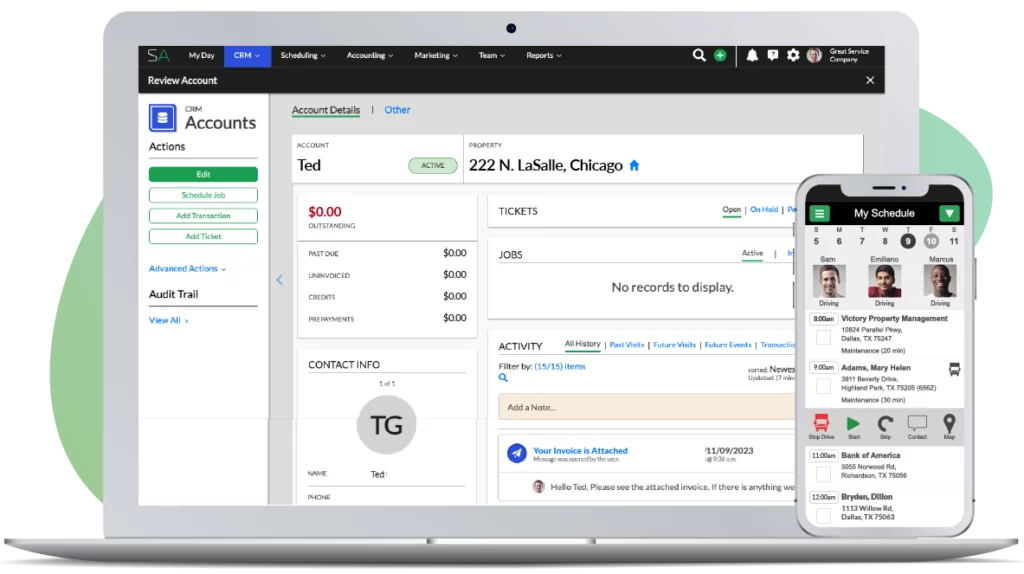In this video, Jonathan explains asset allocation and opportunity cost to help you make the best decisions for your business.
I’ve got so many questions outstanding that I’ve not gotten to. If you’ve asked me a question in the past and I still haven’t responded, I’m sorry. I think I have hundreds. I’m slowly working through this list. I want to read to you a question that I have. I’m going to answer this one.
The question is to please expand on asset utilization, safety risk, and opportunity cost. I’m going to give you an example and try to keep this video short and if I need to expand further I can. Here’s the basic concept. Apparently, I’ve mentioned asset utilization several times. Let me give you an example. Let me pick a simple service to demonstrate this point and you can apply it to your business. I’m going to use an example just to illustrate my point.
Lets imagine that you mow lawns. Optimally, it’s probably true that if you’re doing residential you should be mowing with two man crews, whereas you could be mowing with one, or three, or four. In your consideration about what is most optimal, you have to figure out should I run a two man crew, a three man crew, or again a four man crew and you’ve got to balance that. Your number one expense in your company is labor. You need to be as efficient as possible to drive down that labor cost, but at the same time you’ve got this other nagging problem and that’s called assets. Every time you need to start a new crew you’ve got to buy a new truck, you got to maybe buy a trailer, or a custom bed, and you’ve got to buy mowers, line trimmers, stick edgers, blowers, whatever. If you’re running on bigger properties then you’ve got bigger equipment, you’ve got more expense.
Asset utilization is basically the concept of how you can keep that equipment running as much as possible. For example, lets say that, I’m going to throw out a couple examples here, you have 30% of your properties that require a 61 inch walker or something of the sort and that means that it sits on the trailer 70% of the day unused. That’s not good asset utilization. You’ve got this really expensive piece of equipment, lets just call it 10 grand. I don’t know what the exact cost would be, but this $10,000 piece of equipment that’s only getting used X number of days a week, 30% of the day. That’s not great asset utilization. This really expensive asset you’d really like to have it in production 8 hours a day every day of the week and really be getting your full value out of this thing that you’re paying for. That’s an example of asset utilization.
Back to my example, lets say that you could either use two or three man crews and you’ve determined that two man crews are slightly more efficient than three man crews and I believe that they are. What happens as you are growing the company or scaling the company quickly, you run into a new problem and that is okay. Two man crews are really efficient, but I’ve got one problem. I can’t find enough drivers. I got a second problem, wow the amount of money I’m going to need to add a truck, a trailer, the riding equipment, the mowers, and all the small equipment that’s a lot of expense. If I were to run three man crews I’d need significantly less equipment. Probably not by a third, but I’d need less equipment, less trucks, less everything if I was running three man crews versus two man crews.
Hopefully that makes sense. The concept of asset utilization also gets into, as you’re scaling the company and growing fast, what you can afford. This also plays into the concept which was asked about, opportunity cost. Opportunity cost is simply if you are going to buy something or do something you’re giving up something else. For example, if I choose to focus on fertilization and weed control exclusively, I might be missing out on opportunities in landscape and design build. Or if I spend all my money on hiring a $80,000 a year expert in whatever, there’s an opportunity cost to spending the money on that person that I can’t now invest that money in marketing.
For every action you take, for every dollar you spend, there’s an opportunity cost. It’s the thing you can’t take advantage of. The thing you can’t now do because you spent the money on the employer, spent the money on the marketing. You want to always make sure that you’re spending your money on the right thing. Opportunity cost feeds into asset utilization in the sense that if I decide to run two man crews that means I have to buy more trucks, more equipment, more whatever than if I was running three man crews. I’m going to need more equipment and trucks faster and therefore the money I’m spending on those things there’s an opportunity cost. I have to spend the money on the trucks and the equipment because I choose two man crews instead of three. I can’t now spend it on marketing. I can’t spend it or invest it in some other area of my business.
The third one was safety risk. The more trucks, the more people that you have running around on the road, the more potential risk you have. It’s simple mathematics. The probability of an accident, the probability of something really bad happening increases as you increase the size of your company. The number of people, the number of trucks you’re basically putting out into the roads. When I throw out terms like asset utilization, safety risk, opportunity cost, those are the things I’m thinking about and talking about.
I can’t tell you what the right answer for your business is. I can only tell you that these are things to think about. It’s not just black and white, two man crews versus three man crews. Which one can get the job done three minutes faster? There’s a whole other element to building and scaling the company is if I go with two man crews because yes I can be 5 minutes more efficient per job per day. That means I’m going to need additional assets and additional equipment, which is going to cost me money that presents to me an opportunity cost that I can’t now spend that money on marketing. I’ve got to spend it on assets and if I only run two man crews versus three, I have more trucks in the marketplace, I have more safety risk, more accident potential, more whatever.
I’m not saying don’t run two man crews, I’m just illustrating the example of what those three terms mean to when I throw those out in videos. You’ve got to decide for yourself what’s appropriate for your company. Thank you.



